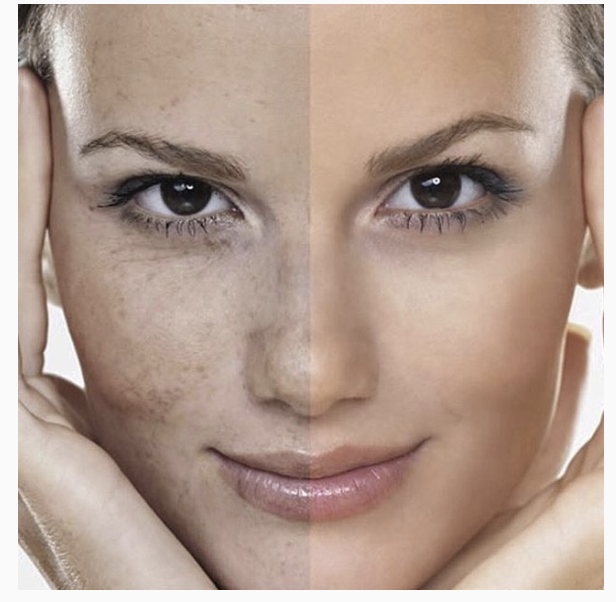Pure Indulgence Beauty Therapy
 While we are young, our skin has a beautifully even skin tone. It looks even in color and has a radiant appearance. As we get older, however, we notice the skin is no longer as clear and even toned, the pigments in our skin are deposited less evenly causing freckles, brown spots, stains and brown marks. These color irregularities are called pigmentation. Where the skin is blotchy with too much pigment, this is called hyper-pigmentation (excessive pigment), cholasma or melasma. WHAT CAUSES BROWN SPOTS? Hyper-pigmentation is caused mainly by UV exposure, hormones, friction, heat, and inflammation. Excess sun exposure, certain hormones (e.g. during pregnancy), too much rubbing (e.g. underarms) heat and inflammation, for example after an acne breakout, are known to cause the skin to trigger more melanin. This is a defense response by the skin. When exposed to these triggers, the skin will thicken and darken to protect itself from further damage. The pigment melanin, which gives our skin the brown color, protects the skin by absorbing UV radiation and preventing burning damage to the skin. This is why people with lighter skin and less melanin burn faster than people with darker skin types and more melanin in their skin. Friction such as excessive rubbing will also trigger the skin to produce and hold onto more dead cells, causing thickening of the skin. In this way, the skin is trying to protect the live skin cells deeper in the skin from damage. The thickening and pigmentation, however, cause the skin to appear patchy, dull and aged. HOW TO PREVENT HYPER-PIGMENTATIONWEAR A BROAD SPECTRUM: SUNSCREEN MINIMUM SPF 30+ Whatever the cause, where possible, first eliminate the cause of brown spots in your skin, where possible. Every single minute you are outdoors during daylight without any sun protection, you are exposing your skin to UV, which triggers melanin production. So the first preventative step you can take is to build in a quality sunscreen of at least SPF 30+ into your daily routine. Select make up with minimum SPF 15 + for added protection. Whenever outdoors, wear a hat, sunglasses with UV protection, stay in the shade whenever possible, and try to avoid direct sun exposure during the middle of the day, when the UV rating is at it’s strongest. USE A TYROSINASE INHIBITOR ON YOUR SKIN EVERY DAY Tyrosinase is the enzyme produced by our skin which triggers melanin production in response to skin damage, or hormones. Using skincare that includes ingredients to inhibit/block melanin production will help reduce brown spots and even out your skin tone. Ingredients to look out for are:
EXFOLIATE YOUR SKIN WITH AHAs Alpha Hydroxyl Acids will remove dead cell build up and surface pigmentation giving your skin an instant brightening result. Professional strength peels are an excellent way to start and fast track your results. At home, choose and use skincare in the form of cleansers, serums and night creams that contain AHAs such as lactic acid or glycolic acid to speed up cellular turnover and remove the melanin build up. Be sure, however, to use these products under the guidance of a well experienced and qualified aesthetician, because using the wrong products or overdoing it can, in fact, trigger more melanin production. Remember, too much exfoliation, will trigger inflammation which will cause the skin to go into the defensive mode by making more melanin and thickening the surface layers. Less is more, and in the case of treating pigmentation disorders, patience with really pay off. Aim to treat uneven pigmentation carefully, slowly over time, which will deliver more lasting results. WHAT TO AVOID
 During summer we come alive. Longer daylight hours and sunny warm weather is the perfect opportunity to have a picnic in the park, a stroll on the beach, potter around in the garden, play sports and go for a swim. The warmer temperatures and sun exposure can lead to oily shiny skin, sun damage, pigmentation, couperose and premature aging. Here are some tips for keeping your skin fresh and glowing during summer and protect your skin from long-term damage. MANAGING OILY SKIN Warmer temperatures and sunlight triggers skin’s natural production of oil. The oil is beneficial to help protect the skin from losing too much moisture. In New Zealand we have the extremes in temperature and strong sun which can make the skin look shiny and could lead to skin clogging, blackheads and breakouts. The first step to managing an oily skin is to balance it perfectly without stripping. Try a lighter milk cleanser for a perfectly cleansed skin. Avoid foamy gel cleansers which contain detergents that strip your skin and can trigger more oil production to make your skin oilier. To keep your skin hydrated and shine free all day long try a mattifying moisturizer. Look for a fluid consistency with added mattifying powders to give your skin a very soft, powdery and matte finish to the skin. These clever moisturizers hydrate the skin where needed and mattify the zones which are too shiny. MANAGING RED SKIN During hotter days, the skin's capillaries dilate to allow the body to cool itself down. This is why the skin turns red when it's hot. Short-term it’s not a problem, as the body cools down the capillaries go back to their normal size. Long-term exposure to the UV light however can damage the collagen and elastin in the capillary wall, causing permanent dilated capillaries called couperose. The first step to prevent this problem is to protect the skin from UV damage where possible. Wear a hat, and a sunscreen and limit the direct exposure to sun. If you find your skin tends to redden in summer or you have visible capillaries, try a serum and a moisturiser which soothes and protects delicate skin. PROTECTING FROM FREE RADICAL DAMAGE All the exposure to sun during summer can cause free radical damage in the skin. Vitamin C and vitamin A are powerful antioxidants which should be included in everybody's skin care during the summer periods and where sun damage, premature aging and pigmentation are evident. During the day, under your moisturizer try a good vitamin C serum. Look for a quality professional strength serum that contains stabilized vitamin C to even the skin tone and reduce the appearance of brown spots. Vitamin C also important in the production of collagen and elastin so will help a sun damaged and ageing skin. At night try a Retinol serum or cream. Look for a cream which is rich in vitamins and minerals and Retinol to improve skin elasticity, restore radiance, smooth superficial imperfections and reduce the appearance of wrinkles and age spots. THE ESSENTIALS OF SUNSCREEN With all that you do to look after your skin, if you do not protect it from the sun with a good sunscreen you will have that much more to cope with in the years to come. Look for a professional formula based on physical reflective agents such as zinc oxide and titanium dioxide as the main ingredients and boosted with antioxidants such as vitamin E or aloe vera for maximum protection. During summer your skin has very different needs than during the cooler periods so it is important to have your skin professionally analysed to determine how your skin is coping and what needs to be managed better for a flawless, bright skin. To discover the best natural solution for your skincare needs, book in a professional consultation with your skincare expert. Thanks to Jana Elston for this article  Protecting the skin from the sun should be a major concern for clients of all ages. As Skin care professionals, we need to educate you on what you can do to prevent damage before it is too late. 1. Preventing sun damage is much easier than restoring wrinkles. It is always easier to prevent than it is to reverse. Sun damage can cause wrinkles, discolored skin, and more serious health consequences AND in some cases, once the damage is done, there is no going back. 2. Avoid deep exfoliating procedures and chemical peels during the summer. These treatments make the skin more photosensitive by removing layers of the epidermis (the top layer of your skin) that can act as a protective shell. The same is true for skin care products formulated with retinol, alpha hydroxyl acids, and other lightening agents. Products containing these ingredients are best used in the evening. 3. Protect your skin with broad-spectrum sunscreen. The SPF number on the bottle indicates how much safe, sun-exposure time can be extended. Determine the time it takes for their unprotected skin to start turning red on a sunny day. Safe, sun-exposure time depends on genetic disposition, location, and the time of day (the sun is most active between 11 a.m. and 4 p.m.). For example, if your skin starts to change color after 10 minutes, by applying sunscreen with SPF 30, your safe, sun-exposure time will be extended 30 times. After 300 minutes, you will need to reapply sunscreen. 4. Location determines the strength of the ultraviolet rays that penetrate the skin. If you are in the water or the snow, your safe, sun-exposure time diminishes significantly, as ultraviolet rays are reflected off the surface of snow or water. 5. The sun is most active at the equator. When traveling north, more protection is needed. Along with sunscreen, wear protective hats and clothing to avoid serious sun damage. 6. Be very careful when at higher elevations. The earth’s atmosphere helps filter ultraviolet rays, so if clients are at higher elevations, like the mountains, they are less protected. 7. Zinc oxide is a great active ingredient for sunscreens. It provides broad-spectrum protection by physically reflecting ultraviolet rays. It has been safely used for generations and is preferred over nanoparticles, which are not as effective. 8. Food can affect how skin responds to the sun. Processed foods with trans fats can contribute to wrinkles, skin discolorations, and other more serious conditions. Colorful, organic fruits and vegetables filled with antioxidants, like tomatoes, will support the skin during sun exposure. 9. Photosensitivity is a side effect of some medications like Accutane, Benadryl, and tetracycline. If clients have to take medical drugs, have them check the list of side effects to determine if they need to take extra precautions in the sun. 10. Elevated estrogen levels and other hormonal changes often result in heightened photosensitivity. This photosensitivity can lead to hyperpigmentation. For example, melasma, the mask of pregnancy, presents as skin discoloration. Women who are taking birth control pills or who are on hormone replacement drugs may also experience similar side effects, unless they take extra measures to protect themselves from the sun. Thanks to Elina Fedotova for inspiration for this blog.  Skin care comes down to practicing good habits. Here are five tips that can help guard against skin cancer, chapped skin, dryness, and more. You need to protect your skin because of the vital role it has protecting your body. Skin care doesn’t have to be complicated or time-consuming, and can quickly become second nature, just like brushing your teeth. These five skin protection tips can keep your skin looking and feeling great, by guarding against a slew of skin woes, from chapped skin to prematurely aging toskin cancer. 1. Limit Sun Exposure You’ve heard the message a zillion times, and there’s good reason for that unrelenting repetition. Ultraviolet rays emitted by the sun cause many types of skin damage:
Using skin care products that offer ultraviolet protection is one of the best ways to help keep your skin looking fresh and youthful: Use sunscreen every day and reapply regularly whenever you're outdoors for extended periods. Cover skin by wearing long-sleeved shirts, pants, and wide-brimmed hats. Stay indoors when the sun is at its most intense, usually between 10 a.m. and 3 p.m. 2. Stay Hydrated Keeping your skin moist is essential to skin protection. Skin that is properly hydrated retains pliability and prevents chapped skin or scaly, flaky skin: Drink lots of water. This is key to hydrating your skin. Use the right moisturizing cream or lotion for your skin type and apply it right after drying off from your bath or shower. Avoid products that contain sodium lauryl sulfate, as this ingredient removes natural oils needed by your skin. Take warm (not hot) showers or baths, and limit them to between 5 and 10 minutes. It seems counterintuitive, but exposure to water actually dries out your skin. If dry skin persists, consider cutting back on the number of baths you take. 3. Take Health Precautions Cold sores are caused by a viral infection of the skin bordering the lips, while bacteria can contribute to acne and other skin conditions. Practicing skin protection means paying close attention to what touches your skin, to lower your chances of exposure to germs: Don't share any personal items, such as lip balms or toothbrushes. Don't share drinks with other people. Avoid touching your face with your fingers or with objects like telephone receivers that have been used by others. 4. Use Gentle Skin Care Washing your face is important to remove dirt, oils, germs, and dead cells. However, scrubbing your face causes irritation that can lead to chapped skin that, in turn, can leave skin vulnerable. For best results, you should:
5. Know Your Skin Pay attention to odd freckles, moles, and growths on your skin, and consult your doctor if you notice any changes. For example, a change in a mole can indicate potential skin cancer. Be sure to treat any cuts that may occur to prevent infection. Other skin conditions that merit a dermatologist visit include frequent acne, inflamed or irritated dry skin, and skin rashes and irritations that don’t go away, as these could be signs of one of the many types of dermatitis, or skin inflammation. With proper skin care to pamper skin from the outside and with a good diet to nourish from within, skin protection comes down to a few simple steps. But should you ever notice any problems, get medical attention to resolve them quickly and avoid putting your skin at risk. |
Categories
All
Archives
September 2019
|
Opening Hours:Monday: Closed
Tuesday: 10am - 7pm Wednesday: 10am - 5pm Thursday: 10am - 8pm Friday: 10am - 5pm Saturday: 10am - 2.30pm Sunday: Closed |
Text:Address:168 Kendal Ave
Burnside Christchurch |
Email: |
Pure Indulgence Beauty Therapy operates by appointment only.
,Since 2010 Pure Indulgence has been emphasising self love and care and building a community of like minded people. We pride ourelves on our educated and professional therapists, whilst also ensuring your experience is relaxing. We are an advanced skin, IPL and beauty clinic situated in Burnside, Christchurch. We comibine relaxation with luxurious skincare and modern technology to bring you treatments that work.
©2023 Pure Indulgence Beauty Therapy Nz Ltd. All Rights Reserved
